 |
|
 |
|
updated to follow: Stratigraphic Guide to the Cromer Knoll, Shetland and Chalk Groups of the North Sea and Norwegian Sea. Felix M. Gradstein & Colin C. Waters (editors), Mike Charnock, Dirk Munsterman, Michelle Hollerbach, Harald Brunstad, Øyvind Hammer & Luis Vergara (contributors). Newsletter on Stratigraphy, vol 49/1 pp71-280, 2016
Shetland Group, Kvitnos Formation
The Kvitskjæving Member is introduced for a unit of interbedded sandstones and mudstones of Santonian age within the Kvitnos Formation developed in the south-west Vestfjorden Basin in block 6610/3 (Nordland III area) of the Norwegian Sea. Limited published data are available on the depositional setting of these sandstones. These sediments are considered to have been deposited mainly as turbidites within a submarine fan system in a deeper marine, outer shelf to upper bathyal paleoenvironment.
Derivatio nominis: Kvitskjæving is the Norwegian name for the Atlantic white-sided dolphin Lagenorhynchus albirostris and appropriately, a close relative of the Kvitnos (white-beaked dolphin). It is endemic to the North Atlantic area. In Norwegian waters, the species is seldom found north of Trondheimsfjorden and generally in water depths between 40-250m related to the continental shelf.
The sandstones are medium grey, clear to transparent quartz, fine to medium, occasionally coarse, poor to moderately sorted, sub-angular to sub-rounded and calcite cemented, moderately hard, sometimes argillaceous, micaceous and slightly glauconitic.
The mudstones are light olive grey to black, firm to moderately hard, blocky, partially silty to sandy, micro-micaceous to micaceous, micro-pyritic, carbonaceous, glauconitic and moderately calcareous, poor visible porosity.
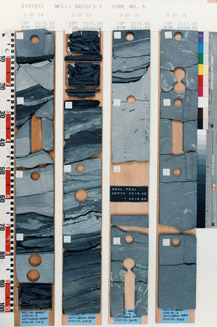 6610/3-1, 2514-2518 m |
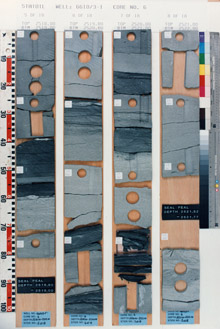 6610/3-1, 2518-2522 m |
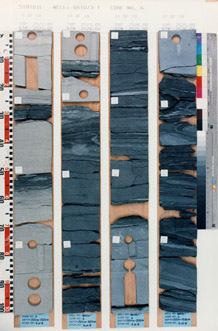 6610/3-1, 2522-2526 m |
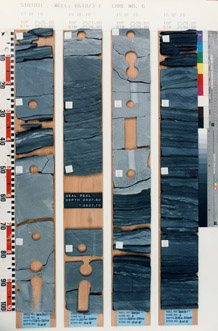 6610/3-1, 2526-2530 m |
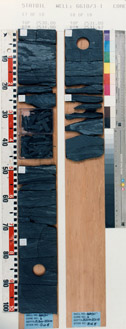 6610/3-1, 2530-2531 m |
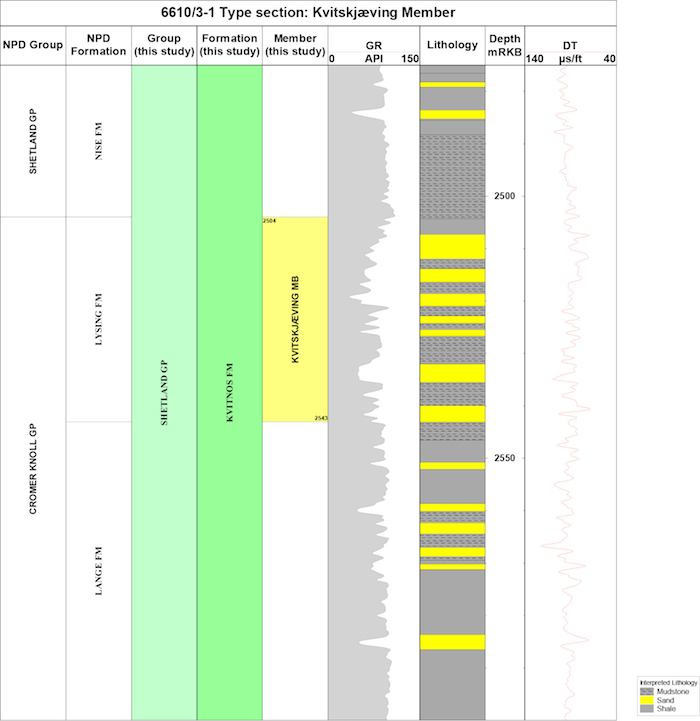
Logs of the type well 6610/3-1 (click to enlarge)
The top of the Kvitskjæving Member is represented by a transition from predominantly argillaceous sediments of the overlying (and encompassing) Kvitnos Formation to a sequence of interbedded sandstones and mudstones. In the type well 6610/3-1 this boundary is represented by a gradual decease in gamma-ray, and increase in sonic velocity values. The upper boundary is better defined on resistivity logs in the type well where there is a downward increase in resistivity values.
In the type well 6610/3-1, the base of the Kvitskjæving Member is marked by a downward gradual change from interbedded sandstones and mudstones to more argillaceous sediments of the underlying Kvitnos Formation. It is characterised on logs by a downward increase in gamma-ray values (Figure 3.28), and a marked decrease in resistivity values but only a weak increase decrease in average sonic velocities.
ST 9104-437 and SP. 335 (well 6610/3-1)
The sporadic records of the Coniacian dino-cyst Florentina deanei above this member in the type well are considered reworked.
In the cored interval of the type well 6610/3-1 Hystrichosphaeridium difficile shows a marked increase in numbers within the middle part of the member that maybe useful for correlative purposes.
The member is assigned to an early Santonian age, Late Cretaceous.
The member is time equivalent to some minor and un-named lower Santonian sands penetrated in the deeper wells in the Vøring Basin e.g. Vema Dome well 6706/11-1 (3737m - 3750mMD RKB).
Limited published data are available on the depositional setting of this member. The sandstones are considered to have been largely deposited as turbidites within a submarine fan system in a deep marine, outer shelf to upper bathyal paleoenvironmental setting. A simple agglutinated foraminiferal assemblage was observed in cores of the type well 6610/3-1 e.g. at 2528.65mMD, particularly with Rhabdammina, in agreement with above paleoenvironmental interpretation. Needle fragments of the planktonic mollusc Inoceramus. Pyritised diatoms and nodosariid - calcareous benthic foraminiferal species are rare, e.g. smooth Lenticulina and Nodosaria spp.
| home | previous page |